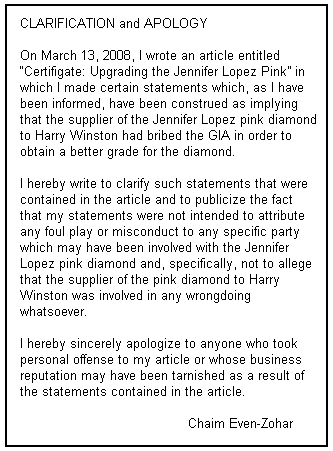Certifigate: Upgrading the Jennifer Lopez Pink
March 13, 08
The day mega-actress Jennifer Lopez broke her engagement to Ben Affleck might have been a sad one for the unlucky groom-not-to-be, but it may have been a fortunate day for the diamond industry. Lopez returned the 6.10-carat pink diamond back to Affleck, who had bought it in 2002 (for a mere $1.2 million). He then took it straight back to the Harry Winston store where he had purchased it. Why were we lucky?
There are strong indications that the stone’s Gemological Institute of America (GIA) color grade may have been fraudulently obtained. Getting it back into the market would en
The stone was originally a fancy orange pink with a weight of 6.97 carats. The GIA graded it as a fancy pink, but it was a split call (i.e. some graders still saw orange). Then it was re-cut down to 6.78 carats and again got certified as fancy pink.
At first, the stone was in the hands of a European group (headed by T.). The group sold the stone (through brokers) to X. [full name is with the editors], an important supplier to Harry Winston. While in the possession of X’s company, the diamond was again re-cut to the 6.10 carats that Lopez received. The final certificate read fancy intense pink, which makes it far more valu
Sometimes bribers are braggers – like having extramarital sex and needing to talk
Admittedly, judgments on grades made in 2002 may look different today because today we are aware of the Certifigate fraud and, more importantly, we know the identity of the “community of bribers.” Involvement in the relevant transaction by members of that not-so-respected club is a factor that cannot be totally ignored when assessing the likelihood of fraud.
When Lopez’s non-groom returned the stone to Harry Winston, the company reportedly agreed to broker the stone. It is relevant that neither Harry Winston nor the seller of the stone to Harry Winston was willing to repurchase the stone. The sale of the pink stone to Lopez took place at a time when Harry Winston was under previous ownership. The Lopez stone originally came to Harry Winston with the GIA certificate, graded in early 2002. There was no reason to seek any re-grading since the customer wanted to buy purely on the basis of the GIA certificate.
The stone never became Harry Winston’s property again. It was later “warehoused” on behalf of Affleck until it was re-sold late in 2006. The prestigious jeweler saw no need for re-certification of the stone. There was no reason to do so as the grading of an important colored diamond can take a long time (greens can take more than a year) and it isn’t anyone’s practice to re-certify a stone unless a problem is suspected.
The GIA is as eager as we are to find out the truth
The Colors of Certifigate
When investigating this story we were struck by another aspect of the Certifigate fraud, which, so far, has not received much attention: the existence of a handful of intermediaries, who are master cutters and who possess the skills to re-cut fancy colored stones in ways that will optimize the color grade – these intermediaries will also “deliver” the best possible grade. We want to make it
Few people have mastered the specific cutting techniques that achieve a stronger face-up color with an even distribution. As color zoning in pink diamonds affects the intensity of color, their orientation (positioning) relative to the t
There is no universal nomenclature (or unanimity among l
The re-cutting of the Lopez pink from 6.97 carats to 6.78 carats didn’t change the color grade but may have been done to improve the appearance in some way. The purpose of the re-cutting may have been to close windows, or to improve the hue distribution, to match another stone or to improve the color. We recognize that there is a large range of price even within a fancy color grade, so even a slight improvement in a stone like this could add value.
A stone's color can be made "purer" through re-cutting by intensifying the color. The goal is to create more internal reflection of the light entering the diamond. It is unreal that a hue change occurs (for example orangy pink to pink), but the GIA says that it has happened. The formal position of the GIA on the Lopez case is that the color was judged as being close to the orangy pink boundary but did not cross it. It is here that those in the market familiar with the stone say differently.
The technical aspects are not relevant to this article. What is crucial to understand is that a handful of people maintain a special relationship with the GIA grading executives enabling them to get better color grades. That is OK when these grades are truly earned; it becomes a different matter when the new grades are tied to the passing of dollar-stuffed brown envelopes.
According to many people we interviewed, favoritism and money (or other goods, such as cars) can be integral to this special relationship. It has been suggested that in certain instances the “favoritism” may give you the right grade; those out of grace might expect a downgrade. Individuals we interviewed gave us various examples, though we don’t know how common these instances were. New Yorkers tell me that the head of the colored diamond division at the GIA l
The Jennifer Lopez pink is an interesting case for illustrative purposes. The owner of the diamond allegedly paid for getting the better grade. But let’s assume for a second that the Lopez grade is correct, in spite of the alleged involvement of a bribe. Is that possible? The investigation conducted by GIA’s counsel, Tom O’Neil, has discovered evidence of the exchange of money (bribes), while, at times, the grade was not necessarily wrong.
These instances may have constituted quite a marginal and irrelevant part of Certifigate, but they need to be mentioned. “The intermediaries that paid bribes may have exaggerated, or even made-up the claim, to get greater reimbursement from their principals,” confided a GIA board official to me. So even if the bragging
So whoever is now wearing the Lopez diamond ring should take up the GIA’s offer for a re-certification – so she does not need to worry (She should also break tradition and not give the diamond back whenever the husband becomes irrelevant or superfluous.)
Damage within the Trade
The consumer is but one of the victims of GIA’s Certifigate. The far greatest damage was done – and still is being done – to the good and decent diamond-industry participants who refused to join the fraud and, consequently, were left losing their business and, in many instances, their livelihood.
One of our sources recalls an incident some five to six years ago where a gentleman who we’ll identify as X [his complete name is in our records] was re-cutting a vivid orange stone, but the GIA gave him only a vivid yellowish orange diamond. So he continued to re-cut the diamond and argued that it was a vivid orange. At the GIA he was told by the color expert K. that “it is no use for you to cut the stone down further. It will never get the vivid grade.” Prima facie, this sounds like honest and helpful advice.
The cutter sold the stone into the market to W., a large dealer in fancy colored goods. A few weeks afterwards, the stone reappeared in the market as vivid orange. The price differential was enormous.
A different source recalls a 16.8-carat light blue pear-shaped stone at the office of a major and highly respected Sightholder, G. Expert cutters re-cut the stone down to 12.89 carats in the hope to get a fancy blue. Though it was borderline, they got a fancy blue. Here, the cutter received similar friendly advice of “don’t re-cut the stone further to get more.” This stone was sold and, lo and behold, a few weeks later, the stone was seen at the offices of W. with a fancy intense blue GIA certificate.
In the small colored goods community, it had become apparent that if you didn’t play the game and were out of favor with the GIA’s power brokers, you really had no chance of staying in the business. Allow me to share with you a very personal testimony of one of those decent individuals who “lost out.”
“For years I worked at a company [whose details are known to us] competing on an uneven playing field because we would not play that same game. I remember several stones that crossed my path which I would not buy because I did not agree with the grades. I don’t just mean I felt a stone was E and not D. There was one specific stone, about 15 carats or so Marquise, that was at auction in Geneva which had a GIA paper reading D Potential. Of course this was a hot stone in the auction. However when I looked at it I felt it was an F color, perhaps E, and that it had whitish graining. My ‘partner’ at the time agreed and we let it go. How surprised was I when
“There were a few more of this type of incidents and after a few years I quit the business. I forever look back at it as ‘being driven out’ of doing what I loved and what I was really good at because I, and my associate partners, refused to cheat. The break point came when I bought an almost 100 carat piece of rough that finished as an E color. To this day I believe it should have been a D, although a low D, however when I showed it to one of your initials [bribers] his comment to me was ‘Why didn’t you bring it to me before you sent it to GIA. I would have sent it for you and taken care of it.’
“Obviously I have several of these stories and though I am now making a living, I feel as though the few got away not only with cheating the public, which is the greater evil, but also with hurting me personally by playing a role in ‘showing’ the partners I had that I could not compete with others in the upgrade and re-cut game. Ultimately I feel vindicated in that I refused to cheat and I know that my partners would not either; however it would have been nice to be
It couldn’t have been said more eloquently. Let’s hope that the Federal U.S. Attorney, Harry Chernoff and GIA’s Tom O’Neil will not ignore these – and many other past and forthcoming – stories, which all cry for action to be taken. A level playing field must be restored.
Have a nice weekend.